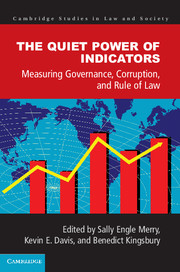Introduction: The Local-Global Life of Indicators: Law, Power, and Resistance
Published online by Cambridge University Press: 05 June 2015
Summary
This book is about the quiet exercise of power through indicators. With the turn to evidence-based governance, reliance on statistical data along with its synthesis into the kinds of scales, ranks, and composite indexes we refer to as indicators has become essential for policy formation and political decision making. The use of indicators in governance has expanded from economic and sector-specific quantitative data to measurement of almost every phenomenon. This book focuses on indicators of governance itself, specifically governance through law: indicators purporting to measure practices or perceptions of good governance, rule of law, corruption, regulatory quality, and related matters.
This volume presents nine original case studies that investigate how leading indicators of legal governance produced with global or transnational scope or aims are created, disseminated, and used, and with what effects. The indicators studied include Freedom House's Freedom in the World indicator, the Global Reporting Initiative's structure for measuring and reporting on corporate social responsibility, the World Justice Project's measurement of the rule of law, the Doing Business index of the International Finance Corporation of the World Bank, the World Bank–supported Worldwide Governance Indicators, the World Bank's Country Performance Institutional Assessment (CPIA), the Transparency International Corruption (Perceptions) index, and several indicators (including some of these) used by the U.S. Millennium Challenge Corporation in determining which countries are eligible to receive certain US aid funds.
The underlying theoretical framework of this volume is the linkage between knowledge and power. Indicators are both a form of knowledge and a technology for governance. Like other forms of knowledge, indicators influence governance when they form the basis for political decision making, public awareness, and the terms in which problems are conceptualized and solutions imagined. Conversely, the kinds of information embodied in indicators, the forms in which they are produced and disseminated, and how they function as knowledge are all influenced by governance practices.
- Type
- Chapter
- Information
- The Quiet Power of IndicatorsMeasuring Governance, Corruption, and Rule of Law, pp. 1 - 24Publisher: Cambridge University PressPrint publication year: 2015
References
- 16
- Cited by

